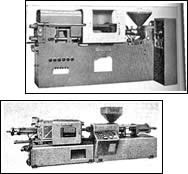No. 1 - Reciprocating-Screw Injection
A paradigm shift in injection molding machinery design began in the 1950s following the invention of the reciprocating screw.
A paradigm shift in injection molding machinery design began in the 1950s following the invention of the reciprocating screw. Until that time, all injection machines used plunger injection, though some two-stage machines in the middle to late 1950s had non-reciprocating screw preplasticators.
In the U.S., William Willert is generally regarded as the pioneer of the reciprocating screw. He developed it in 1952 and patented it in 1956 while v.p. at Egan Machinery. Some credit Hans Beck of BASF in Germany with inventing the first reciprocating-screw machine in 1943. He filed a patent but reciprocating-screw machines were not commercialized in Europe or the U.S. until at least 13 years later. When they did hit the market, they caught on quickly.
The most significant advantage of the reciprocating screw over the plunger was the screw’s improved ability to heat and mix the resin. Plunger ma chines had only heat and compaction pressure available to melt the material and no effective means of mixing or homogenization. Before the screw arrived, the preplasticating section of a two-stage machine had a heated “torpedo” or “spreader” fixed in the center of the barrel to promote melting, but it was stationary and thus im parted no frictional heating or mixing.
For the first time, screw plasticating delivered a homogenous melt with close temperature control and uniform viscosity, resulting in up to 50% faster production rates than plungers. It also speeded material or color changes, and since resin was fully melted upon entering the mold, lower injection pressures could be used. These benefits were provided by early fixed-screw preplasticators, but the two-stage design was more complex and costly than a single-stage reciprocating screw.
There are conflicting accounts of exactly when commercial production of reciprocating screws started. Reed-Prentice is said to have built a 600-ton reciprocating-screw machine in 1953, but its first commercial splash was apparently not until the introduction of the Jetflo press at NPE in 1958.
Meanwhile, HPM sources have said that company built the clamp end of the first domestic reciprocating-screw machine in 1958 (the injection end presumably supplied by Egan.) That machine may have been a prototype, however, which apparently went to DuPont’s research lab. Some sources report that the first models with a reciprocating screw as standard first appeared in Germany in 1956 or ’57 from Ankerwerk and from Eckert & Ziegler GmbH in cooperation with Reifenhauser.
U.S. interest in the new reciprocating screws certainly accelerated after 1960, when nearly every major American machinery maker offered a press with such a screw. New Britain Machine Co. in New Britain, Conn., began building the Ankerwerk machine. National Automatic Tool Co. (Natco) in Richmond, Ind., may have been the first to standardize on reciprocating screws in 1961. As late as 1963, Van Dorn Iron Works introduced a new press with a choice of screw or plunger. In that year, Paul A. Plasse of Arthur D. Little wrote in Plastics Technology, “The move is definitely to screw-type machines,” despite the large installed base of plunger machines.
But there were skeptics initially. In 1959, John Reib, founder and president of Conair, told an SPE meeting in Erie, Pa., about the screw injection machines he had just seen at the German “K” Show in Dusseldorf. According to Reib’s 1996 memoir, The Making of Conair, Ren Morse, president of Injection Molders Supply (IMS) “belittled my comments and said, ‘It’s just a fad; it will never make it in this country.’”
In 1962, two Dow Chemical Co. researchers published an article in Plastics Technology documenting the processing advantages of the reciprocating screw over the plunger. They concluded, “Data is plentiful in support of the [reciprocating-screw] system, but this does not mean that the choice is so obvious, nor that once it is made the processing will be straightforward.” Plasse, in his 1963 article, wrote that “the most difficult problem involves development of polymers that will not undergo appreciable shear degradation under the screw’s mixing action.”
Read Next
See Recyclers Close the Loop on Trade Show Production Scrap at NPE2024
A collaboration between show organizer PLASTICS, recycler CPR and size reduction experts WEIMA and Conair recovered and recycled all production scrap at NPE2024.
Read MoreFor PLASTICS' CEO Seaholm, NPE to Shine Light on Sustainability Successes
With advocacy, communication and sustainability as three main pillars, Seaholm leads a trade association to NPE that ‘is more active today than we have ever been.’
Read More


.jpg;width=700;quality=80)







